Comprehensive Strategic Planning Report: Telstra Company, Australia
VerifiedAdded on 2021/04/24
|11
|2466
|64
Report
AI Summary
This report presents a strategic plan developed for Telstra, Australia's largest telecommunication company. It begins with an executive summary and then delves into Telstra's vision, mission, and business activities, highlighting its extensive telecommunication services, including mobile, television, and internet. The report analyzes stakeholders, emphasizing the importance of consulting them, and outlines various strategies to involve them in the decision-making process. The core of the report focuses on Telstra's strategic plans, including improving customer satisfaction, expanding market ventures, simplifying business operations, and managing risks. It includes a market analysis, SWOT analysis, competitor analysis, and key strategic goals. The report also details action plans, monitoring and control mechanisms, and a SWOT analysis of the strategies. Additionally, it explores Telstra's potential alliances, risk mitigation strategies, and a cost-benefit analysis. The report concludes with a discussion of compliance and legislation within the telecommunications industry and references supporting the analysis.
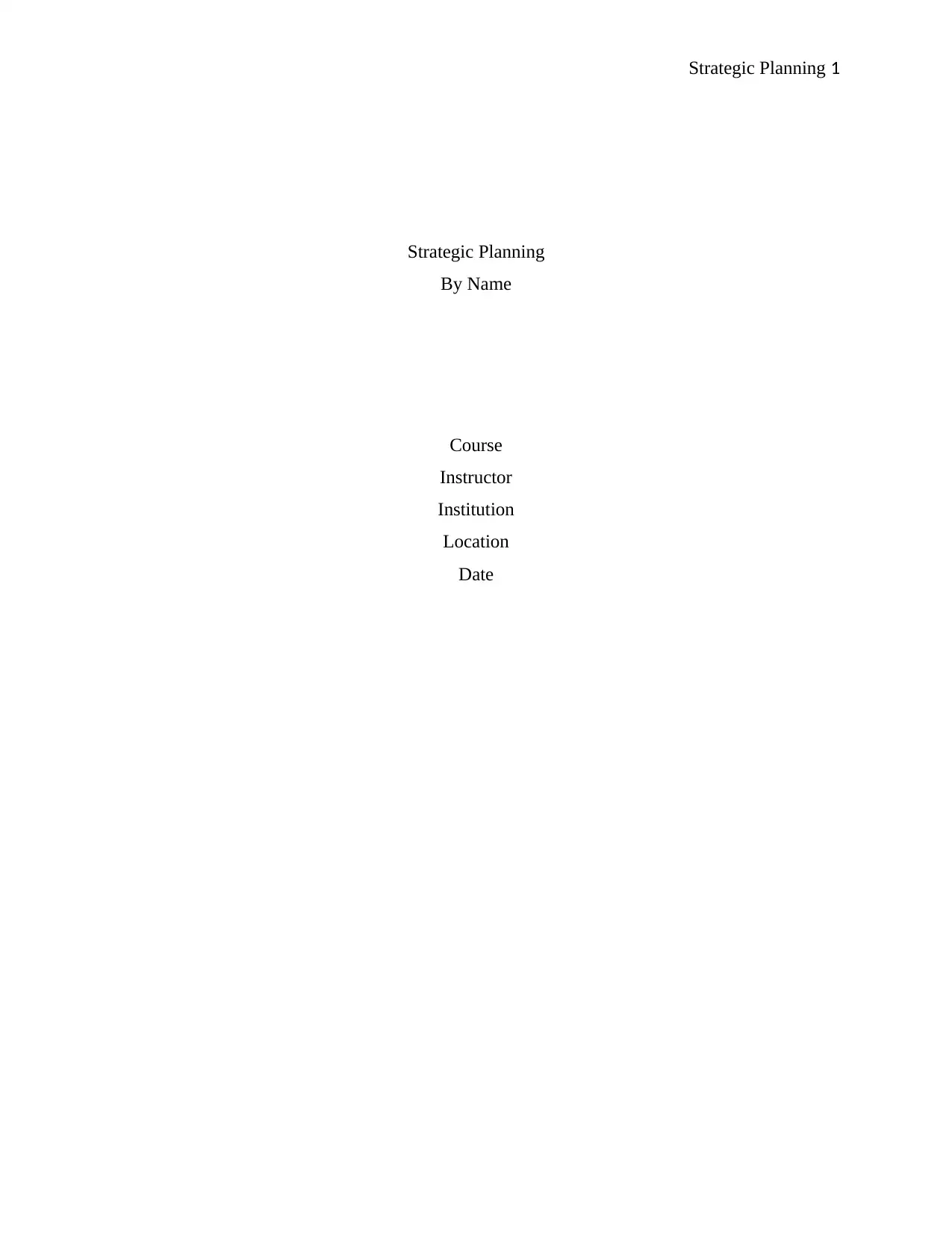
Strategic Planning 1
Strategic Planning
By Name
Course
Instructor
Institution
Location
Date
Strategic Planning
By Name
Course
Instructor
Institution
Location
Date
Paraphrase This Document
Need a fresh take? Get an instant paraphrase of this document with our AI Paraphraser
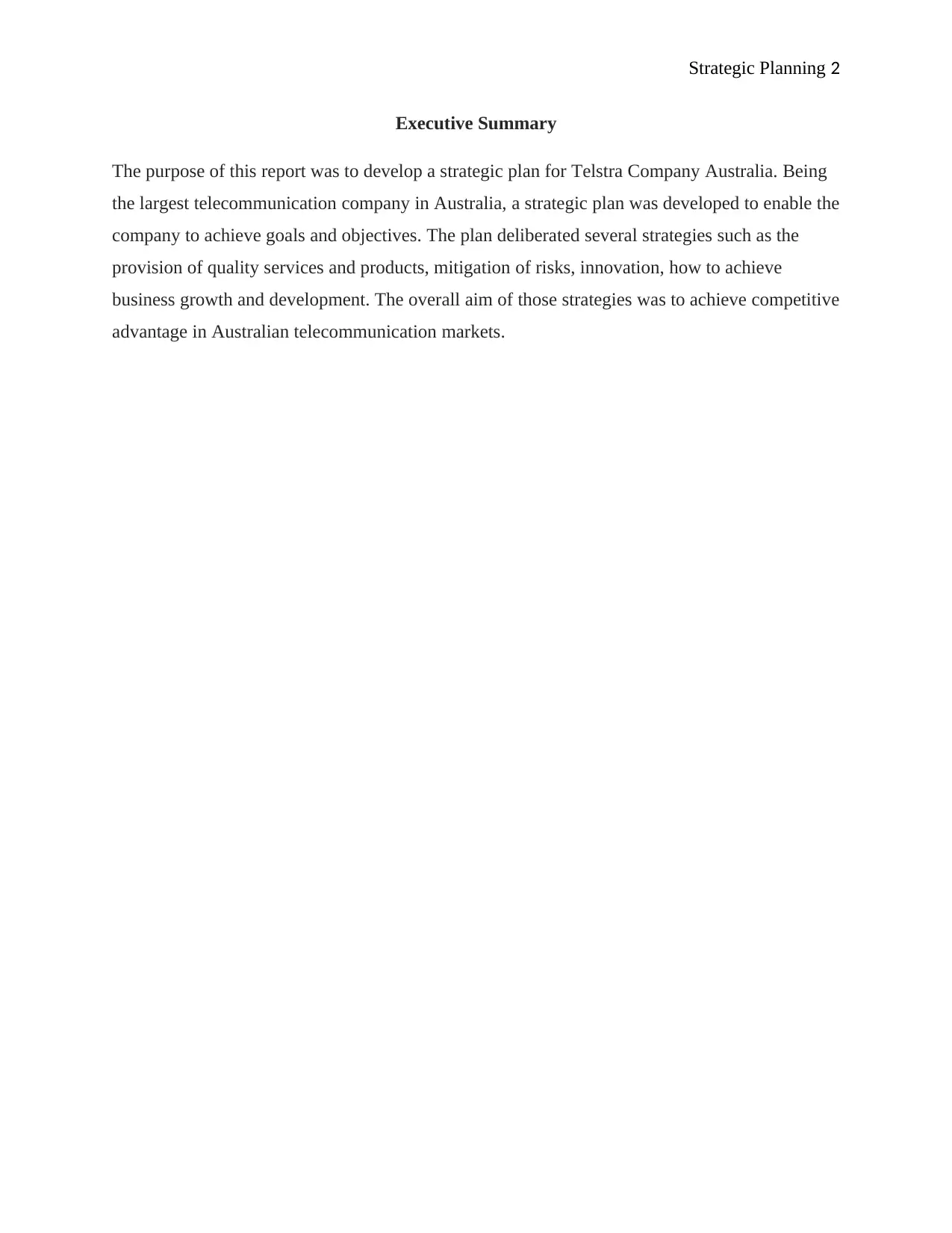
Strategic Planning 2
Executive Summary
The purpose of this report was to develop a strategic plan for Telstra Company Australia. Being
the largest telecommunication company in Australia, a strategic plan was developed to enable the
company to achieve goals and objectives. The plan deliberated several strategies such as the
provision of quality services and products, mitigation of risks, innovation, how to achieve
business growth and development. The overall aim of those strategies was to achieve competitive
advantage in Australian telecommunication markets.
Executive Summary
The purpose of this report was to develop a strategic plan for Telstra Company Australia. Being
the largest telecommunication company in Australia, a strategic plan was developed to enable the
company to achieve goals and objectives. The plan deliberated several strategies such as the
provision of quality services and products, mitigation of risks, innovation, how to achieve
business growth and development. The overall aim of those strategies was to achieve competitive
advantage in Australian telecommunication markets.
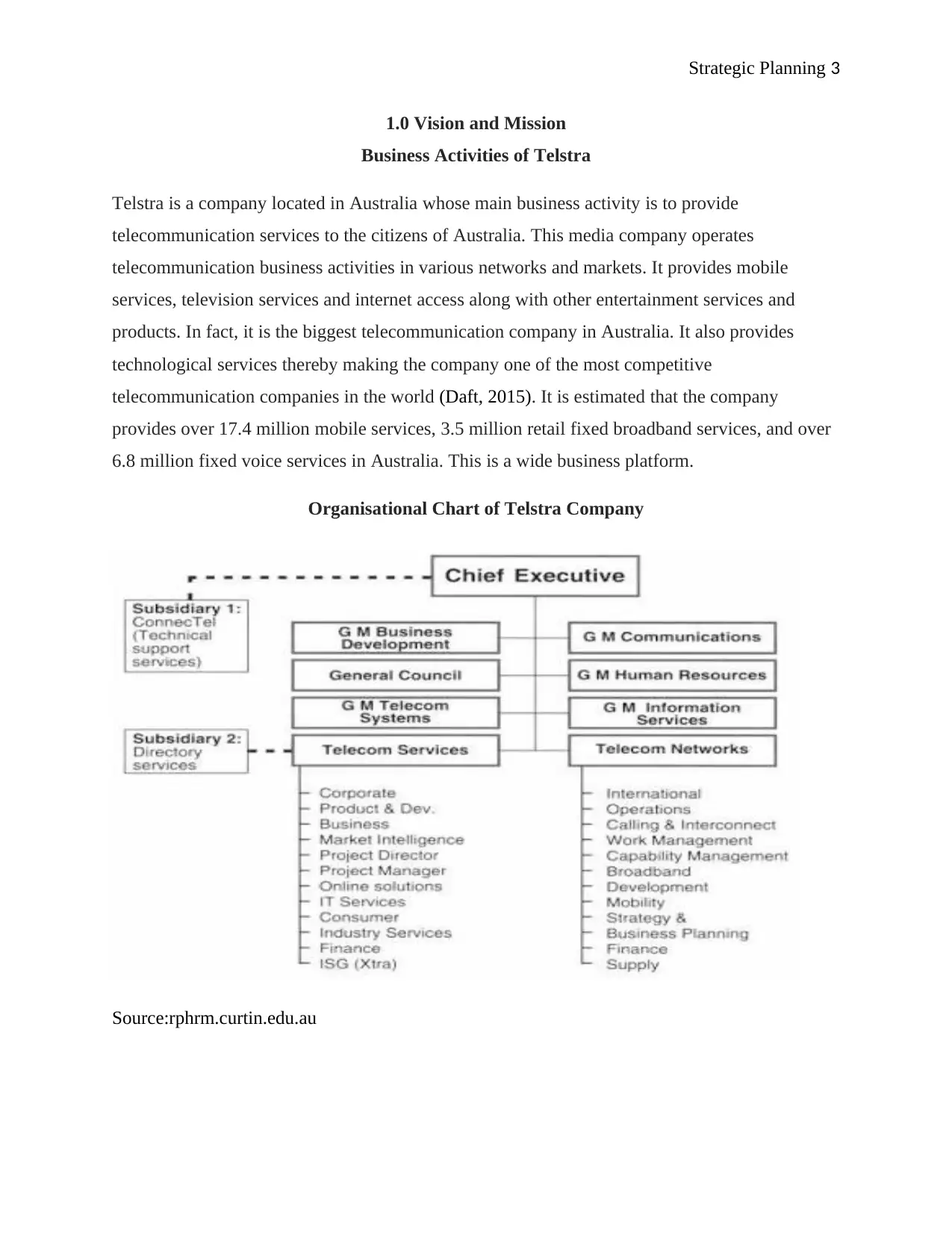
Strategic Planning 3
1.0 Vision and Mission
Business Activities of Telstra
Telstra is a company located in Australia whose main business activity is to provide
telecommunication services to the citizens of Australia. This media company operates
telecommunication business activities in various networks and markets. It provides mobile
services, television services and internet access along with other entertainment services and
products. In fact, it is the biggest telecommunication company in Australia. It also provides
technological services thereby making the company one of the most competitive
telecommunication companies in the world (Daft, 2015). It is estimated that the company
provides over 17.4 million mobile services, 3.5 million retail fixed broadband services, and over
6.8 million fixed voice services in Australia. This is a wide business platform.
Organisational Chart of Telstra Company
Source:rphrm.curtin.edu.au
1.0 Vision and Mission
Business Activities of Telstra
Telstra is a company located in Australia whose main business activity is to provide
telecommunication services to the citizens of Australia. This media company operates
telecommunication business activities in various networks and markets. It provides mobile
services, television services and internet access along with other entertainment services and
products. In fact, it is the biggest telecommunication company in Australia. It also provides
technological services thereby making the company one of the most competitive
telecommunication companies in the world (Daft, 2015). It is estimated that the company
provides over 17.4 million mobile services, 3.5 million retail fixed broadband services, and over
6.8 million fixed voice services in Australia. This is a wide business platform.
Organisational Chart of Telstra Company
Source:rphrm.curtin.edu.au
⊘ This is a preview!⊘
Do you want full access?
Subscribe today to unlock all pages.

Trusted by 1+ million students worldwide
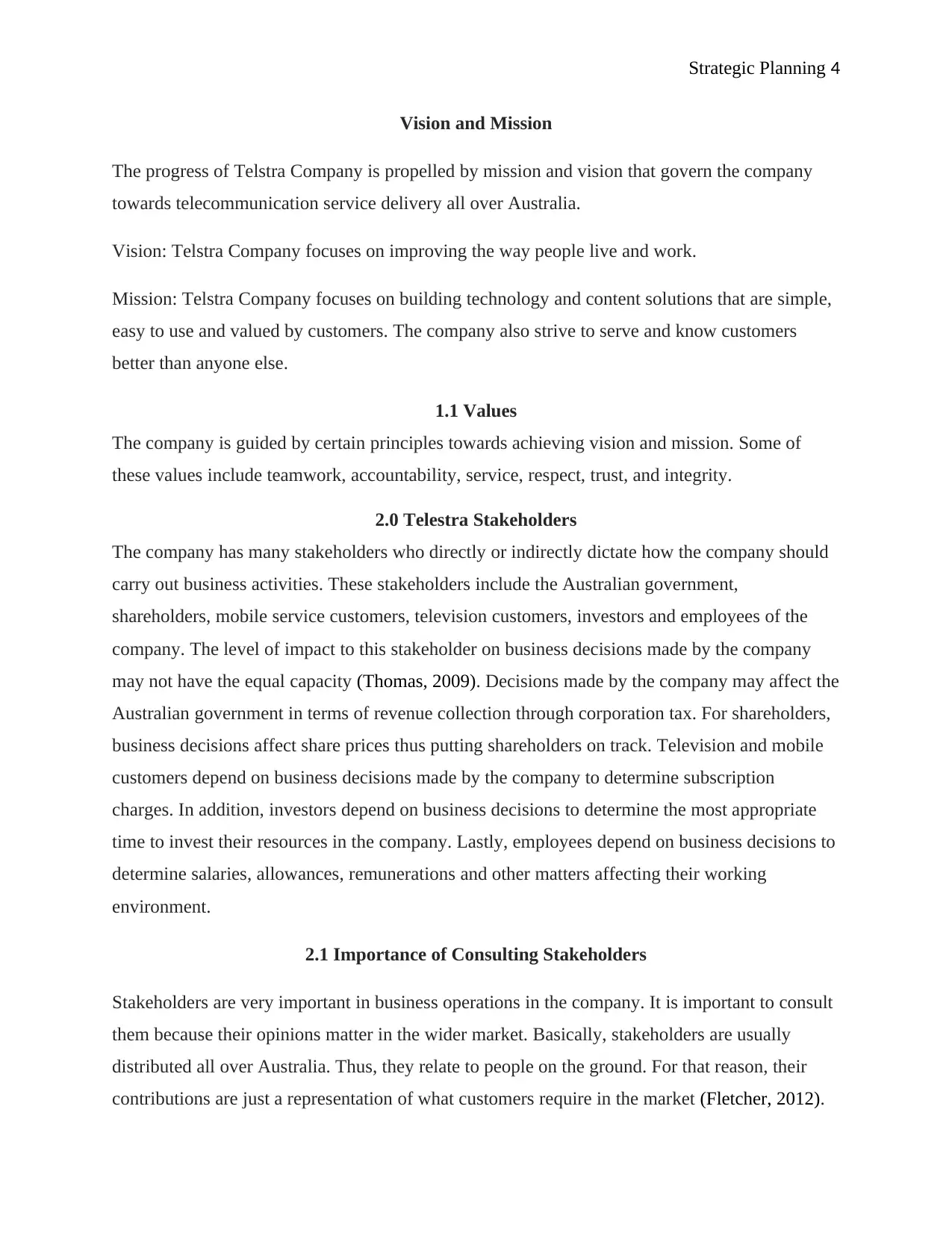
Strategic Planning 4
Vision and Mission
The progress of Telstra Company is propelled by mission and vision that govern the company
towards telecommunication service delivery all over Australia.
Vision: Telstra Company focuses on improving the way people live and work.
Mission: Telstra Company focuses on building technology and content solutions that are simple,
easy to use and valued by customers. The company also strive to serve and know customers
better than anyone else.
1.1 Values
The company is guided by certain principles towards achieving vision and mission. Some of
these values include teamwork, accountability, service, respect, trust, and integrity.
2.0 Telestra Stakeholders
The company has many stakeholders who directly or indirectly dictate how the company should
carry out business activities. These stakeholders include the Australian government,
shareholders, mobile service customers, television customers, investors and employees of the
company. The level of impact to this stakeholder on business decisions made by the company
may not have the equal capacity (Thomas, 2009). Decisions made by the company may affect the
Australian government in terms of revenue collection through corporation tax. For shareholders,
business decisions affect share prices thus putting shareholders on track. Television and mobile
customers depend on business decisions made by the company to determine subscription
charges. In addition, investors depend on business decisions to determine the most appropriate
time to invest their resources in the company. Lastly, employees depend on business decisions to
determine salaries, allowances, remunerations and other matters affecting their working
environment.
2.1 Importance of Consulting Stakeholders
Stakeholders are very important in business operations in the company. It is important to consult
them because their opinions matter in the wider market. Basically, stakeholders are usually
distributed all over Australia. Thus, they relate to people on the ground. For that reason, their
contributions are just a representation of what customers require in the market (Fletcher, 2012).
Vision and Mission
The progress of Telstra Company is propelled by mission and vision that govern the company
towards telecommunication service delivery all over Australia.
Vision: Telstra Company focuses on improving the way people live and work.
Mission: Telstra Company focuses on building technology and content solutions that are simple,
easy to use and valued by customers. The company also strive to serve and know customers
better than anyone else.
1.1 Values
The company is guided by certain principles towards achieving vision and mission. Some of
these values include teamwork, accountability, service, respect, trust, and integrity.
2.0 Telestra Stakeholders
The company has many stakeholders who directly or indirectly dictate how the company should
carry out business activities. These stakeholders include the Australian government,
shareholders, mobile service customers, television customers, investors and employees of the
company. The level of impact to this stakeholder on business decisions made by the company
may not have the equal capacity (Thomas, 2009). Decisions made by the company may affect the
Australian government in terms of revenue collection through corporation tax. For shareholders,
business decisions affect share prices thus putting shareholders on track. Television and mobile
customers depend on business decisions made by the company to determine subscription
charges. In addition, investors depend on business decisions to determine the most appropriate
time to invest their resources in the company. Lastly, employees depend on business decisions to
determine salaries, allowances, remunerations and other matters affecting their working
environment.
2.1 Importance of Consulting Stakeholders
Stakeholders are very important in business operations in the company. It is important to consult
them because their opinions matter in the wider market. Basically, stakeholders are usually
distributed all over Australia. Thus, they relate to people on the ground. For that reason, their
contributions are just a representation of what customers require in the market (Fletcher, 2012).
Paraphrase This Document
Need a fresh take? Get an instant paraphrase of this document with our AI Paraphraser
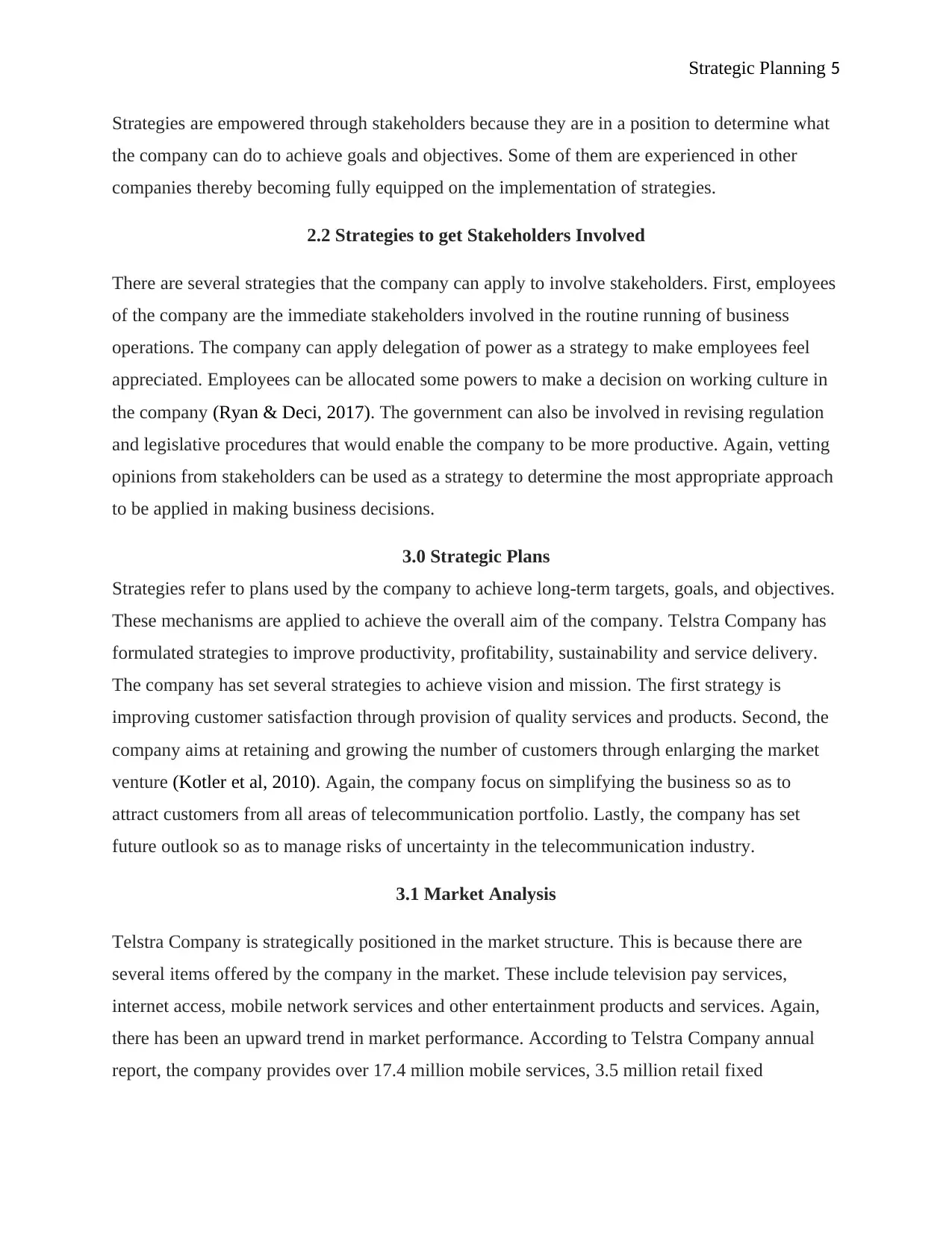
Strategic Planning 5
Strategies are empowered through stakeholders because they are in a position to determine what
the company can do to achieve goals and objectives. Some of them are experienced in other
companies thereby becoming fully equipped on the implementation of strategies.
2.2 Strategies to get Stakeholders Involved
There are several strategies that the company can apply to involve stakeholders. First, employees
of the company are the immediate stakeholders involved in the routine running of business
operations. The company can apply delegation of power as a strategy to make employees feel
appreciated. Employees can be allocated some powers to make a decision on working culture in
the company (Ryan & Deci, 2017). The government can also be involved in revising regulation
and legislative procedures that would enable the company to be more productive. Again, vetting
opinions from stakeholders can be used as a strategy to determine the most appropriate approach
to be applied in making business decisions.
3.0 Strategic Plans
Strategies refer to plans used by the company to achieve long-term targets, goals, and objectives.
These mechanisms are applied to achieve the overall aim of the company. Telstra Company has
formulated strategies to improve productivity, profitability, sustainability and service delivery.
The company has set several strategies to achieve vision and mission. The first strategy is
improving customer satisfaction through provision of quality services and products. Second, the
company aims at retaining and growing the number of customers through enlarging the market
venture (Kotler et al, 2010). Again, the company focus on simplifying the business so as to
attract customers from all areas of telecommunication portfolio. Lastly, the company has set
future outlook so as to manage risks of uncertainty in the telecommunication industry.
3.1 Market Analysis
Telstra Company is strategically positioned in the market structure. This is because there are
several items offered by the company in the market. These include television pay services,
internet access, mobile network services and other entertainment products and services. Again,
there has been an upward trend in market performance. According to Telstra Company annual
report, the company provides over 17.4 million mobile services, 3.5 million retail fixed
Strategies are empowered through stakeholders because they are in a position to determine what
the company can do to achieve goals and objectives. Some of them are experienced in other
companies thereby becoming fully equipped on the implementation of strategies.
2.2 Strategies to get Stakeholders Involved
There are several strategies that the company can apply to involve stakeholders. First, employees
of the company are the immediate stakeholders involved in the routine running of business
operations. The company can apply delegation of power as a strategy to make employees feel
appreciated. Employees can be allocated some powers to make a decision on working culture in
the company (Ryan & Deci, 2017). The government can also be involved in revising regulation
and legislative procedures that would enable the company to be more productive. Again, vetting
opinions from stakeholders can be used as a strategy to determine the most appropriate approach
to be applied in making business decisions.
3.0 Strategic Plans
Strategies refer to plans used by the company to achieve long-term targets, goals, and objectives.
These mechanisms are applied to achieve the overall aim of the company. Telstra Company has
formulated strategies to improve productivity, profitability, sustainability and service delivery.
The company has set several strategies to achieve vision and mission. The first strategy is
improving customer satisfaction through provision of quality services and products. Second, the
company aims at retaining and growing the number of customers through enlarging the market
venture (Kotler et al, 2010). Again, the company focus on simplifying the business so as to
attract customers from all areas of telecommunication portfolio. Lastly, the company has set
future outlook so as to manage risks of uncertainty in the telecommunication industry.
3.1 Market Analysis
Telstra Company is strategically positioned in the market structure. This is because there are
several items offered by the company in the market. These include television pay services,
internet access, mobile network services and other entertainment products and services. Again,
there has been an upward trend in market performance. According to Telstra Company annual
report, the company provides over 17.4 million mobile services, 3.5 million retail fixed
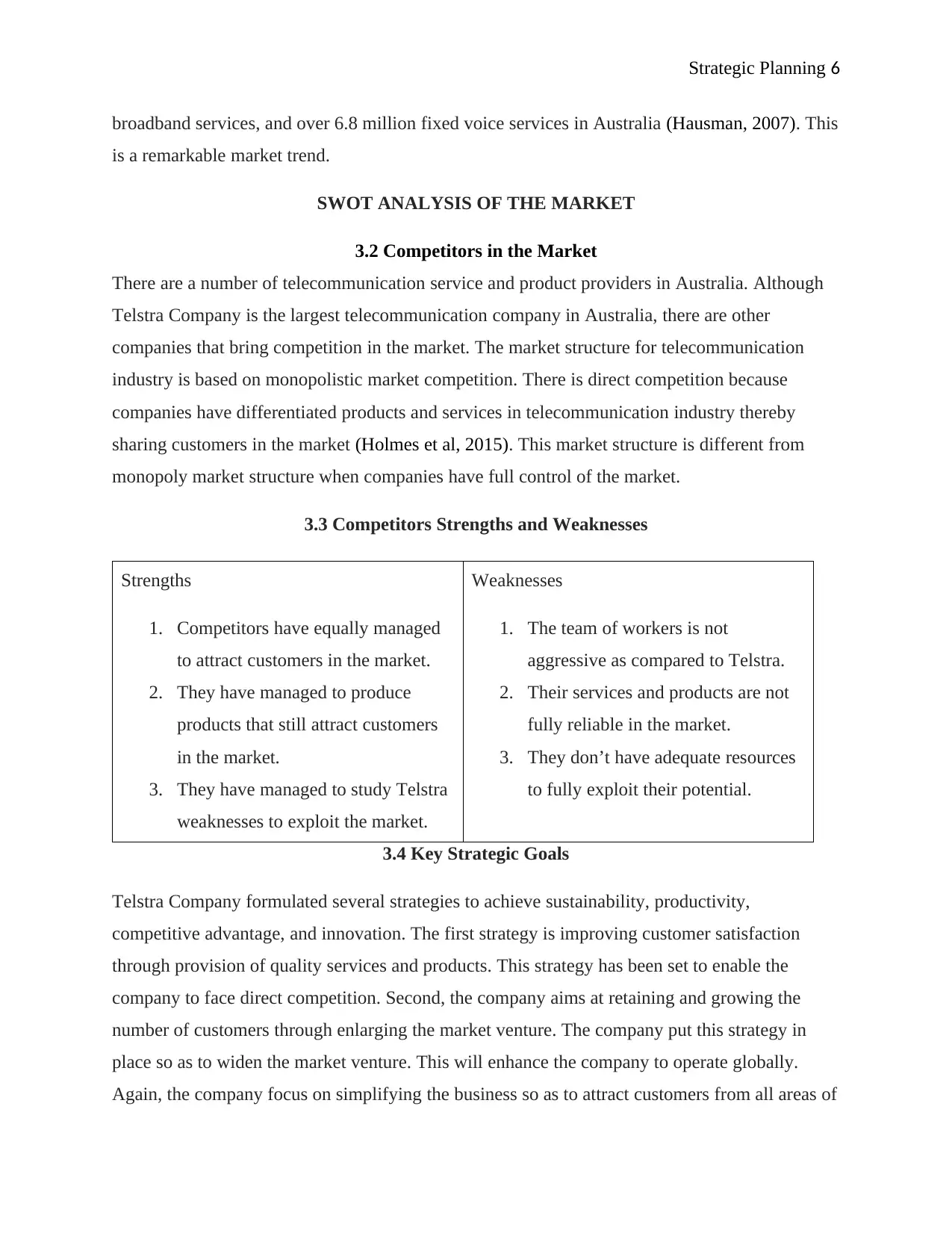
Strategic Planning 6
broadband services, and over 6.8 million fixed voice services in Australia (Hausman, 2007). This
is a remarkable market trend.
SWOT ANALYSIS OF THE MARKET
3.2 Competitors in the Market
There are a number of telecommunication service and product providers in Australia. Although
Telstra Company is the largest telecommunication company in Australia, there are other
companies that bring competition in the market. The market structure for telecommunication
industry is based on monopolistic market competition. There is direct competition because
companies have differentiated products and services in telecommunication industry thereby
sharing customers in the market (Holmes et al, 2015). This market structure is different from
monopoly market structure when companies have full control of the market.
3.3 Competitors Strengths and Weaknesses
Strengths
1. Competitors have equally managed
to attract customers in the market.
2. They have managed to produce
products that still attract customers
in the market.
3. They have managed to study Telstra
weaknesses to exploit the market.
Weaknesses
1. The team of workers is not
aggressive as compared to Telstra.
2. Their services and products are not
fully reliable in the market.
3. They don’t have adequate resources
to fully exploit their potential.
3.4 Key Strategic Goals
Telstra Company formulated several strategies to achieve sustainability, productivity,
competitive advantage, and innovation. The first strategy is improving customer satisfaction
through provision of quality services and products. This strategy has been set to enable the
company to face direct competition. Second, the company aims at retaining and growing the
number of customers through enlarging the market venture. The company put this strategy in
place so as to widen the market venture. This will enhance the company to operate globally.
Again, the company focus on simplifying the business so as to attract customers from all areas of
broadband services, and over 6.8 million fixed voice services in Australia (Hausman, 2007). This
is a remarkable market trend.
SWOT ANALYSIS OF THE MARKET
3.2 Competitors in the Market
There are a number of telecommunication service and product providers in Australia. Although
Telstra Company is the largest telecommunication company in Australia, there are other
companies that bring competition in the market. The market structure for telecommunication
industry is based on monopolistic market competition. There is direct competition because
companies have differentiated products and services in telecommunication industry thereby
sharing customers in the market (Holmes et al, 2015). This market structure is different from
monopoly market structure when companies have full control of the market.
3.3 Competitors Strengths and Weaknesses
Strengths
1. Competitors have equally managed
to attract customers in the market.
2. They have managed to produce
products that still attract customers
in the market.
3. They have managed to study Telstra
weaknesses to exploit the market.
Weaknesses
1. The team of workers is not
aggressive as compared to Telstra.
2. Their services and products are not
fully reliable in the market.
3. They don’t have adequate resources
to fully exploit their potential.
3.4 Key Strategic Goals
Telstra Company formulated several strategies to achieve sustainability, productivity,
competitive advantage, and innovation. The first strategy is improving customer satisfaction
through provision of quality services and products. This strategy has been set to enable the
company to face direct competition. Second, the company aims at retaining and growing the
number of customers through enlarging the market venture. The company put this strategy in
place so as to widen the market venture. This will enhance the company to operate globally.
Again, the company focus on simplifying the business so as to attract customers from all areas of
⊘ This is a preview!⊘
Do you want full access?
Subscribe today to unlock all pages.

Trusted by 1+ million students worldwide
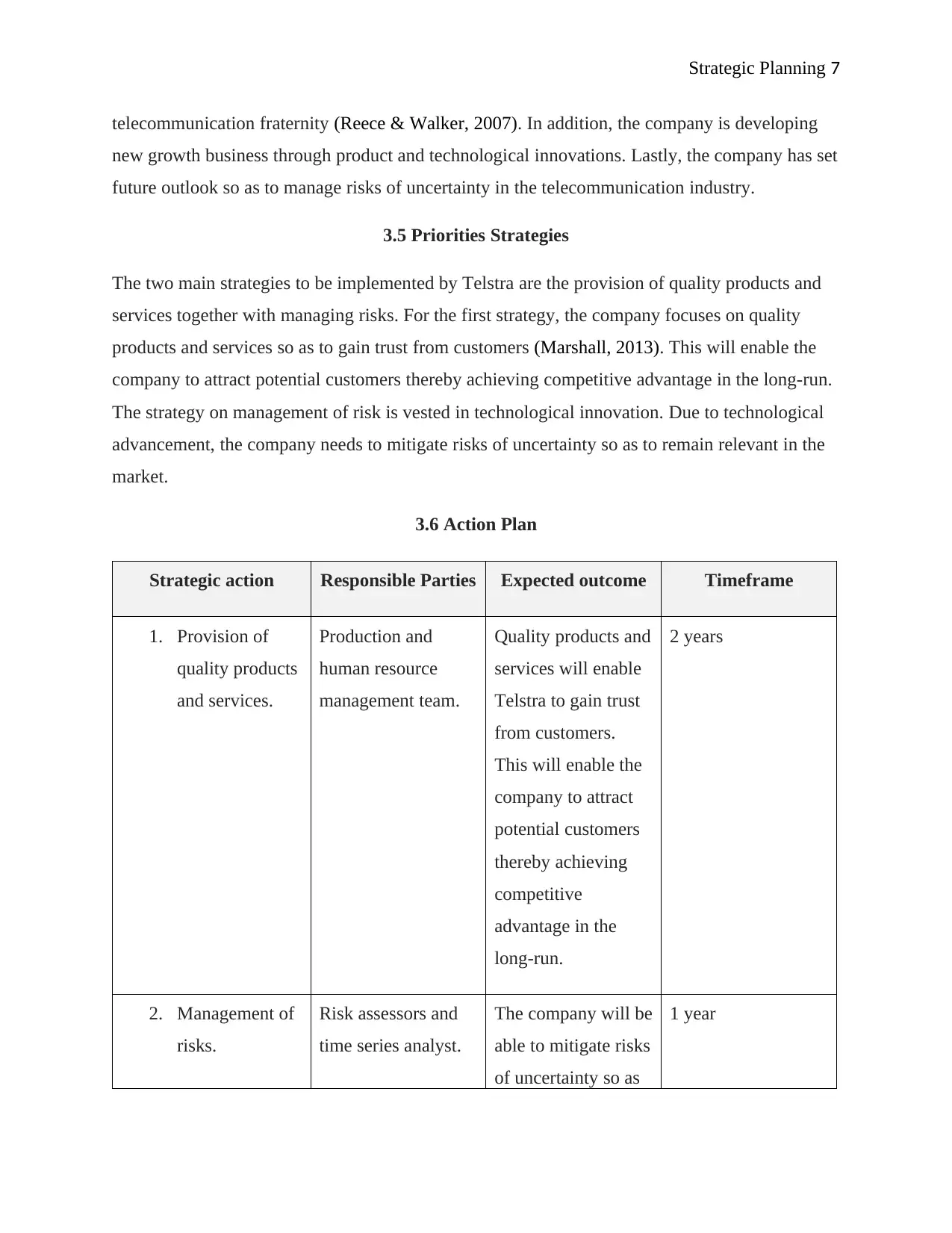
Strategic Planning 7
telecommunication fraternity (Reece & Walker, 2007). In addition, the company is developing
new growth business through product and technological innovations. Lastly, the company has set
future outlook so as to manage risks of uncertainty in the telecommunication industry.
3.5 Priorities Strategies
The two main strategies to be implemented by Telstra are the provision of quality products and
services together with managing risks. For the first strategy, the company focuses on quality
products and services so as to gain trust from customers (Marshall, 2013). This will enable the
company to attract potential customers thereby achieving competitive advantage in the long-run.
The strategy on management of risk is vested in technological innovation. Due to technological
advancement, the company needs to mitigate risks of uncertainty so as to remain relevant in the
market.
3.6 Action Plan
Strategic action Responsible Parties Expected outcome Timeframe
1. Provision of
quality products
and services.
Production and
human resource
management team.
Quality products and
services will enable
Telstra to gain trust
from customers.
This will enable the
company to attract
potential customers
thereby achieving
competitive
advantage in the
long-run.
2 years
2. Management of
risks.
Risk assessors and
time series analyst.
The company will be
able to mitigate risks
of uncertainty so as
1 year
telecommunication fraternity (Reece & Walker, 2007). In addition, the company is developing
new growth business through product and technological innovations. Lastly, the company has set
future outlook so as to manage risks of uncertainty in the telecommunication industry.
3.5 Priorities Strategies
The two main strategies to be implemented by Telstra are the provision of quality products and
services together with managing risks. For the first strategy, the company focuses on quality
products and services so as to gain trust from customers (Marshall, 2013). This will enable the
company to attract potential customers thereby achieving competitive advantage in the long-run.
The strategy on management of risk is vested in technological innovation. Due to technological
advancement, the company needs to mitigate risks of uncertainty so as to remain relevant in the
market.
3.6 Action Plan
Strategic action Responsible Parties Expected outcome Timeframe
1. Provision of
quality products
and services.
Production and
human resource
management team.
Quality products and
services will enable
Telstra to gain trust
from customers.
This will enable the
company to attract
potential customers
thereby achieving
competitive
advantage in the
long-run.
2 years
2. Management of
risks.
Risk assessors and
time series analyst.
The company will be
able to mitigate risks
of uncertainty so as
1 year
Paraphrase This Document
Need a fresh take? Get an instant paraphrase of this document with our AI Paraphraser
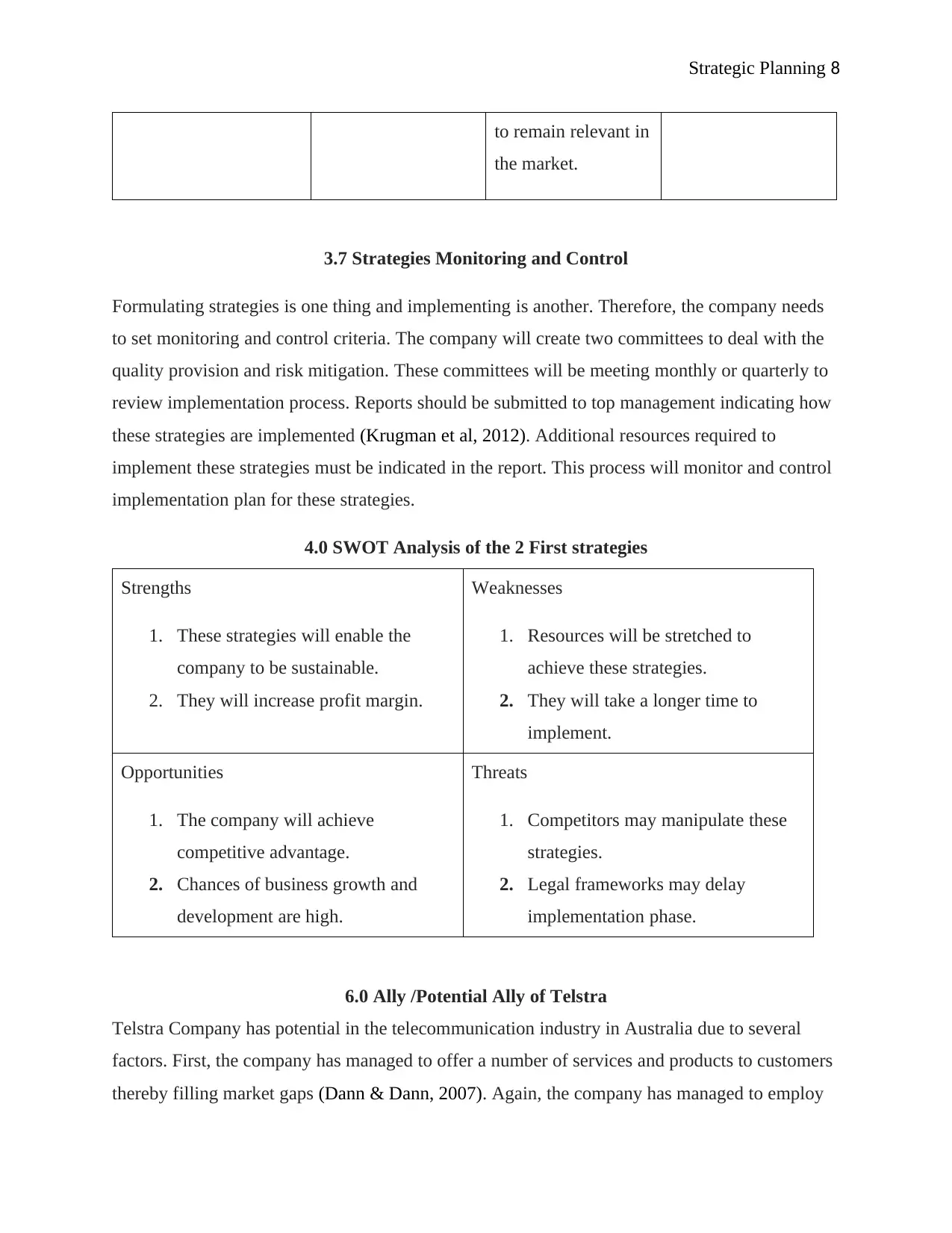
Strategic Planning 8
to remain relevant in
the market.
3.7 Strategies Monitoring and Control
Formulating strategies is one thing and implementing is another. Therefore, the company needs
to set monitoring and control criteria. The company will create two committees to deal with the
quality provision and risk mitigation. These committees will be meeting monthly or quarterly to
review implementation process. Reports should be submitted to top management indicating how
these strategies are implemented (Krugman et al, 2012). Additional resources required to
implement these strategies must be indicated in the report. This process will monitor and control
implementation plan for these strategies.
4.0 SWOT Analysis of the 2 First strategies
Strengths
1. These strategies will enable the
company to be sustainable.
2. They will increase profit margin.
Weaknesses
1. Resources will be stretched to
achieve these strategies.
2. They will take a longer time to
implement.
Opportunities
1. The company will achieve
competitive advantage.
2. Chances of business growth and
development are high.
Threats
1. Competitors may manipulate these
strategies.
2. Legal frameworks may delay
implementation phase.
6.0 Ally /Potential Ally of Telstra
Telstra Company has potential in the telecommunication industry in Australia due to several
factors. First, the company has managed to offer a number of services and products to customers
thereby filling market gaps (Dann & Dann, 2007). Again, the company has managed to employ
to remain relevant in
the market.
3.7 Strategies Monitoring and Control
Formulating strategies is one thing and implementing is another. Therefore, the company needs
to set monitoring and control criteria. The company will create two committees to deal with the
quality provision and risk mitigation. These committees will be meeting monthly or quarterly to
review implementation process. Reports should be submitted to top management indicating how
these strategies are implemented (Krugman et al, 2012). Additional resources required to
implement these strategies must be indicated in the report. This process will monitor and control
implementation plan for these strategies.
4.0 SWOT Analysis of the 2 First strategies
Strengths
1. These strategies will enable the
company to be sustainable.
2. They will increase profit margin.
Weaknesses
1. Resources will be stretched to
achieve these strategies.
2. They will take a longer time to
implement.
Opportunities
1. The company will achieve
competitive advantage.
2. Chances of business growth and
development are high.
Threats
1. Competitors may manipulate these
strategies.
2. Legal frameworks may delay
implementation phase.
6.0 Ally /Potential Ally of Telstra
Telstra Company has potential in the telecommunication industry in Australia due to several
factors. First, the company has managed to offer a number of services and products to customers
thereby filling market gaps (Dann & Dann, 2007). Again, the company has managed to employ
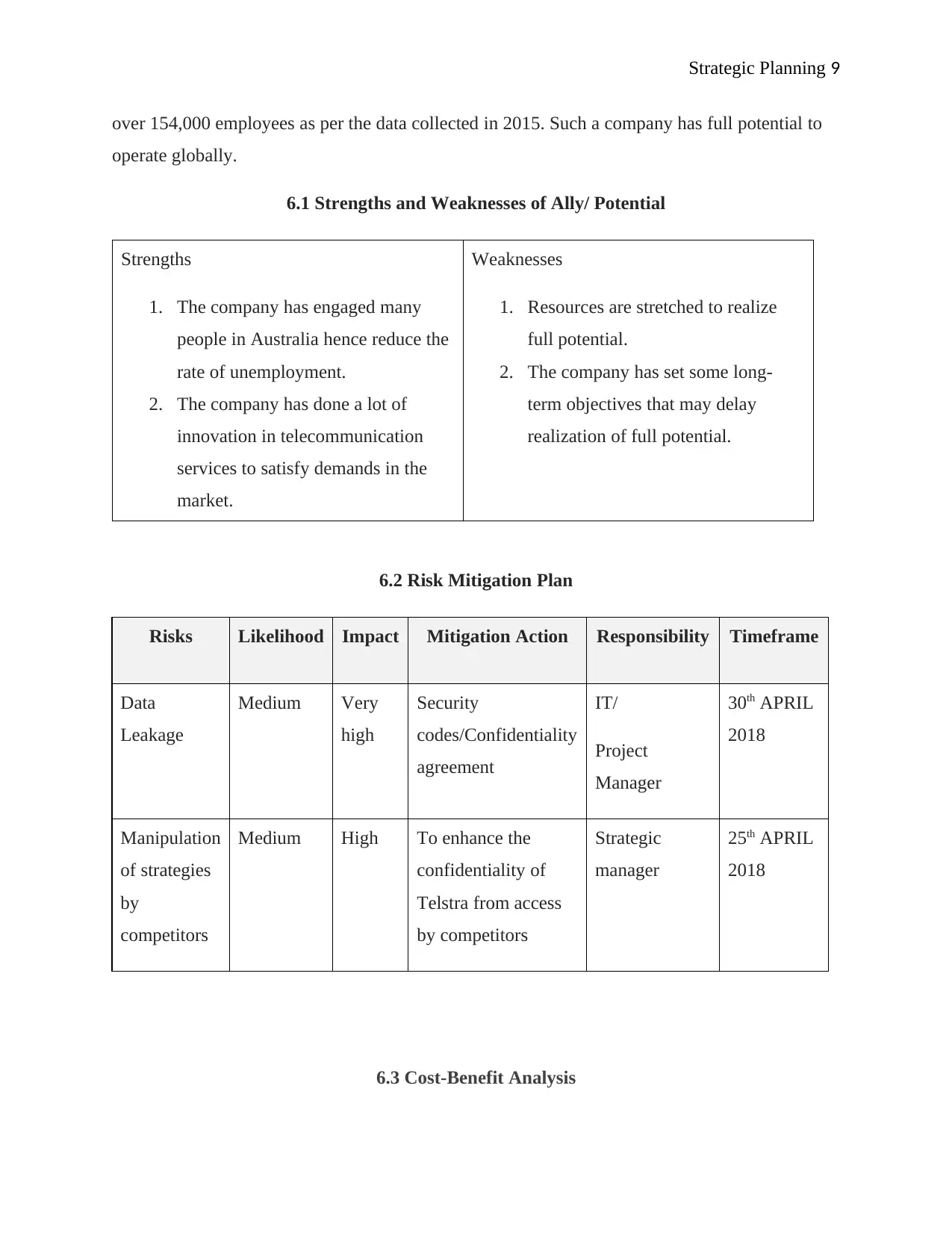
Strategic Planning 9
over 154,000 employees as per the data collected in 2015. Such a company has full potential to
operate globally.
6.1 Strengths and Weaknesses of Ally/ Potential
Strengths
1. The company has engaged many
people in Australia hence reduce the
rate of unemployment.
2. The company has done a lot of
innovation in telecommunication
services to satisfy demands in the
market.
Weaknesses
1. Resources are stretched to realize
full potential.
2. The company has set some long-
term objectives that may delay
realization of full potential.
6.2 Risk Mitigation Plan
Risks Likelihood Impact Mitigation Action Responsibility Timeframe
Data
Leakage
Medium Very
high
Security
codes/Confidentiality
agreement
IT/
Project
Manager
30th APRIL
2018
Manipulation
of strategies
by
competitors
Medium High To enhance the
confidentiality of
Telstra from access
by competitors
Strategic
manager
25th APRIL
2018
6.3 Cost-Benefit Analysis
over 154,000 employees as per the data collected in 2015. Such a company has full potential to
operate globally.
6.1 Strengths and Weaknesses of Ally/ Potential
Strengths
1. The company has engaged many
people in Australia hence reduce the
rate of unemployment.
2. The company has done a lot of
innovation in telecommunication
services to satisfy demands in the
market.
Weaknesses
1. Resources are stretched to realize
full potential.
2. The company has set some long-
term objectives that may delay
realization of full potential.
6.2 Risk Mitigation Plan
Risks Likelihood Impact Mitigation Action Responsibility Timeframe
Data
Leakage
Medium Very
high
Security
codes/Confidentiality
agreement
IT/
Project
Manager
30th APRIL
2018
Manipulation
of strategies
by
competitors
Medium High To enhance the
confidentiality of
Telstra from access
by competitors
Strategic
manager
25th APRIL
2018
6.3 Cost-Benefit Analysis
⊘ This is a preview!⊘
Do you want full access?
Subscribe today to unlock all pages.

Trusted by 1+ million students worldwide
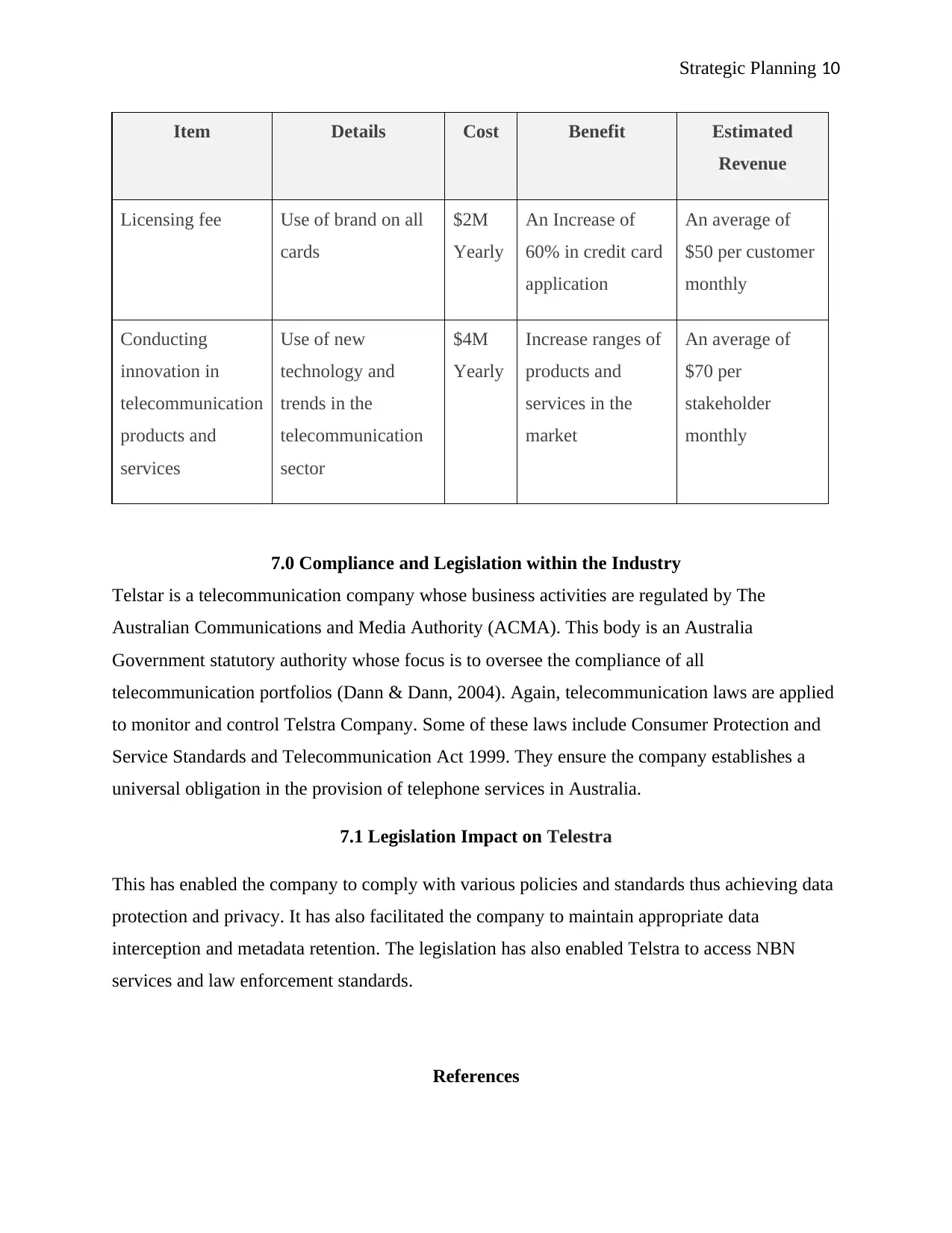
Strategic Planning 10
Item Details Cost Benefit Estimated
Revenue
Licensing fee Use of brand on all
cards
$2M
Yearly
An Increase of
60% in credit card
application
An average of
$50 per customer
monthly
Conducting
innovation in
telecommunication
products and
services
Use of new
technology and
trends in the
telecommunication
sector
$4M
Yearly
Increase ranges of
products and
services in the
market
An average of
$70 per
stakeholder
monthly
7.0 Compliance and Legislation within the Industry
Telstar is a telecommunication company whose business activities are regulated by The
Australian Communications and Media Authority (ACMA). This body is an Australia
Government statutory authority whose focus is to oversee the compliance of all
telecommunication portfolios (Dann & Dann, 2004). Again, telecommunication laws are applied
to monitor and control Telstra Company. Some of these laws include Consumer Protection and
Service Standards and Telecommunication Act 1999. They ensure the company establishes a
universal obligation in the provision of telephone services in Australia.
7.1 Legislation Impact on Telestra
This has enabled the company to comply with various policies and standards thus achieving data
protection and privacy. It has also facilitated the company to maintain appropriate data
interception and metadata retention. The legislation has also enabled Telstra to access NBN
services and law enforcement standards.
References
Item Details Cost Benefit Estimated
Revenue
Licensing fee Use of brand on all
cards
$2M
Yearly
An Increase of
60% in credit card
application
An average of
$50 per customer
monthly
Conducting
innovation in
telecommunication
products and
services
Use of new
technology and
trends in the
telecommunication
sector
$4M
Yearly
Increase ranges of
products and
services in the
market
An average of
$70 per
stakeholder
monthly
7.0 Compliance and Legislation within the Industry
Telstar is a telecommunication company whose business activities are regulated by The
Australian Communications and Media Authority (ACMA). This body is an Australia
Government statutory authority whose focus is to oversee the compliance of all
telecommunication portfolios (Dann & Dann, 2004). Again, telecommunication laws are applied
to monitor and control Telstra Company. Some of these laws include Consumer Protection and
Service Standards and Telecommunication Act 1999. They ensure the company establishes a
universal obligation in the provision of telephone services in Australia.
7.1 Legislation Impact on Telestra
This has enabled the company to comply with various policies and standards thus achieving data
protection and privacy. It has also facilitated the company to maintain appropriate data
interception and metadata retention. The legislation has also enabled Telstra to access NBN
services and law enforcement standards.
References
Paraphrase This Document
Need a fresh take? Get an instant paraphrase of this document with our AI Paraphraser
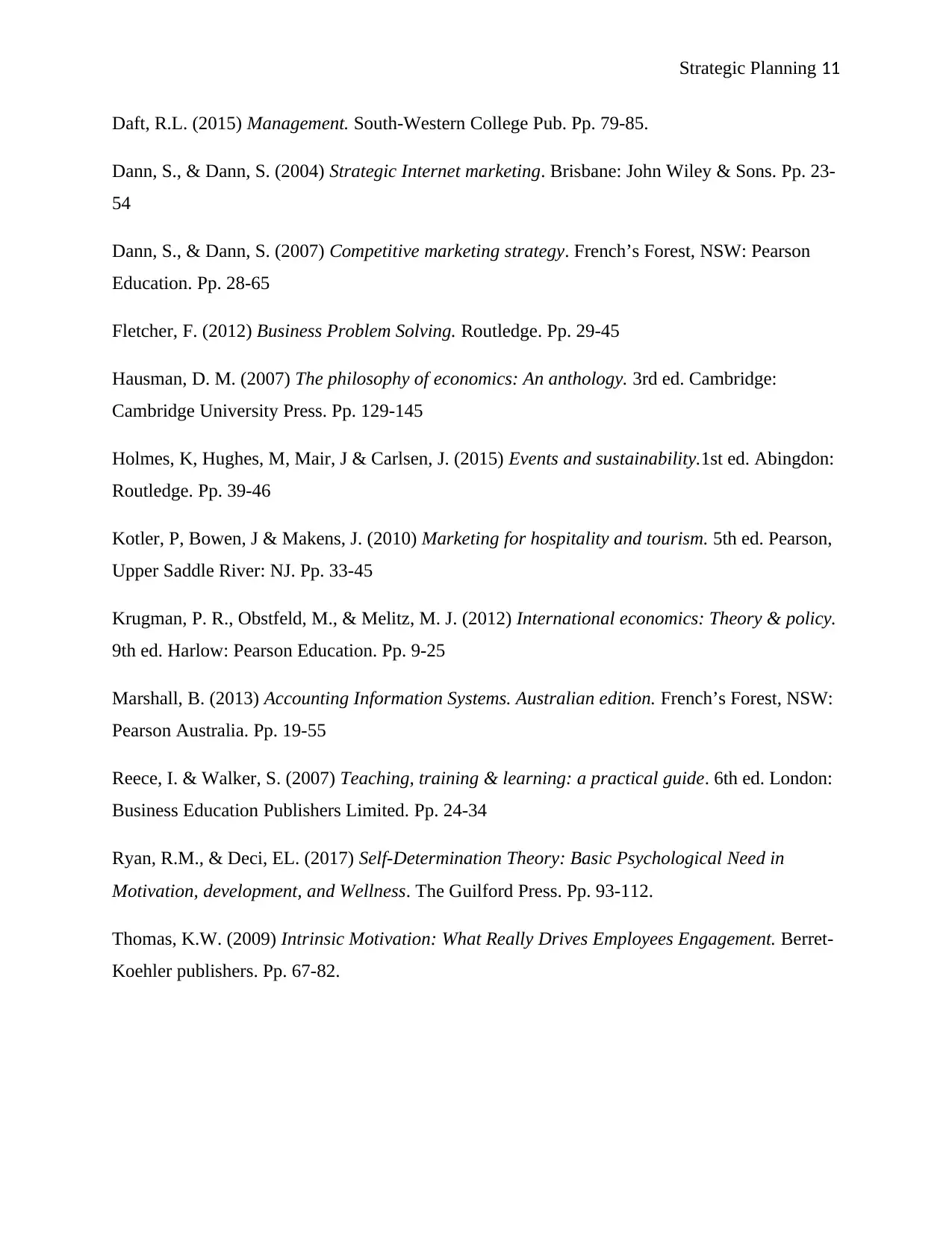
Strategic Planning 11
Daft, R.L. (2015) Management. South-Western College Pub. Pp. 79-85.
Dann, S., & Dann, S. (2004) Strategic Internet marketing. Brisbane: John Wiley & Sons. Pp. 23-
54
Dann, S., & Dann, S. (2007) Competitive marketing strategy. French’s Forest, NSW: Pearson
Education. Pp. 28-65
Fletcher, F. (2012) Business Problem Solving. Routledge. Pp. 29-45
Hausman, D. M. (2007) The philosophy of economics: An anthology. 3rd ed. Cambridge:
Cambridge University Press. Pp. 129-145
Holmes, K, Hughes, M, Mair, J & Carlsen, J. (2015) Events and sustainability.1st ed. Abingdon:
Routledge. Pp. 39-46
Kotler, P, Bowen, J & Makens, J. (2010) Marketing for hospitality and tourism. 5th ed. Pearson,
Upper Saddle River: NJ. Pp. 33-45
Krugman, P. R., Obstfeld, M., & Melitz, M. J. (2012) International economics: Theory & policy.
9th ed. Harlow: Pearson Education. Pp. 9-25
Marshall, B. (2013) Accounting Information Systems. Australian edition. French’s Forest, NSW:
Pearson Australia. Pp. 19-55
Reece, I. & Walker, S. (2007) Teaching, training & learning: a practical guide. 6th ed. London:
Business Education Publishers Limited. Pp. 24-34
Ryan, R.M., & Deci, EL. (2017) Self-Determination Theory: Basic Psychological Need in
Motivation, development, and Wellness. The Guilford Press. Pp. 93-112.
Thomas, K.W. (2009) Intrinsic Motivation: What Really Drives Employees Engagement. Berret-
Koehler publishers. Pp. 67-82.
Daft, R.L. (2015) Management. South-Western College Pub. Pp. 79-85.
Dann, S., & Dann, S. (2004) Strategic Internet marketing. Brisbane: John Wiley & Sons. Pp. 23-
54
Dann, S., & Dann, S. (2007) Competitive marketing strategy. French’s Forest, NSW: Pearson
Education. Pp. 28-65
Fletcher, F. (2012) Business Problem Solving. Routledge. Pp. 29-45
Hausman, D. M. (2007) The philosophy of economics: An anthology. 3rd ed. Cambridge:
Cambridge University Press. Pp. 129-145
Holmes, K, Hughes, M, Mair, J & Carlsen, J. (2015) Events and sustainability.1st ed. Abingdon:
Routledge. Pp. 39-46
Kotler, P, Bowen, J & Makens, J. (2010) Marketing for hospitality and tourism. 5th ed. Pearson,
Upper Saddle River: NJ. Pp. 33-45
Krugman, P. R., Obstfeld, M., & Melitz, M. J. (2012) International economics: Theory & policy.
9th ed. Harlow: Pearson Education. Pp. 9-25
Marshall, B. (2013) Accounting Information Systems. Australian edition. French’s Forest, NSW:
Pearson Australia. Pp. 19-55
Reece, I. & Walker, S. (2007) Teaching, training & learning: a practical guide. 6th ed. London:
Business Education Publishers Limited. Pp. 24-34
Ryan, R.M., & Deci, EL. (2017) Self-Determination Theory: Basic Psychological Need in
Motivation, development, and Wellness. The Guilford Press. Pp. 93-112.
Thomas, K.W. (2009) Intrinsic Motivation: What Really Drives Employees Engagement. Berret-
Koehler publishers. Pp. 67-82.
1 out of 11
Related Documents
Your All-in-One AI-Powered Toolkit for Academic Success.
+13062052269
info@desklib.com
Available 24*7 on WhatsApp / Email
![[object Object]](/_next/static/media/star-bottom.7253800d.svg)
Unlock your academic potential
Copyright © 2020–2025 A2Z Services. All Rights Reserved. Developed and managed by ZUCOL.





